On December 28th, 1807, the King of Naples, Giuseppe Bonaparte, signed the decree for the establishment of the Royal Botanical Garden, so fulfilling a wish of Ferdinand IV of Bourbon, which had been prevented by the Neapolitan Revolutionof 1799. The lands adjacent to the Albergo dei Poveri, then owned by the clergy of Santa Maria della Pace and by the Hospital of La Cava, were expropriated for the project.
"The instruction of the public" and the multiplication "of the spices useful for health, agriculture, and industry" are expressions that can be found in the official documents of the time to describe the purpose of the royal institution. The Neapolitan Garden was therefore born under the sign of modernity and from the very beginning stood out for the multiplicity of functions it performed and for its vast plant heritage.
Giuliano de Fazio and Gaspare Maria Paoletti are the architects who signed the project. De Fazio designed the imposing facade, the main avenue perpendicular to the facade, and the one that leads to the Castle. The Temperate House (“Stufa Temperata”), in neoclassical style, whose appearance recalls the orangeries of the eighteenth century, is also De Fazio's work. The “Stufa Temperata” originally housed citrus plants during the unfavorable season. Paoletti, on the other hand, designed the lower part of the Royal Botanical Garden.
The first director, Michele Tenore, led the Garden for 50 years, from its opening in 1810 until the fall of the Bourbon regime and the Unification of Italy. He was succeeded by 12 appointed directors who have contributed in various ways to the establishment of new areas and the enrichment of the collections.
Currently, the total area of the Botanical Garden of Naples is almost 12 hectares, on which about 9,000 plant species are on display for a total of about 25,000 specimens.
The Botanical Garden of the University of Naples. Historical notes
The Botanical Garden of Naples was founded in the early 19th century, during the period when the city of Naples was dominated by the French (the so-called French decennium). The French gave life to an idea previously conceived by Ferdinand IV of Bourbon, which had been prevented from being implemented by the revolutionary uprisings of 1799. The decree establishing this structure is dated December 28th, 1807, and bears the signature of King Giuseppe Bonaparte, Napoleon's brother. Article 1 of this decree expropriated those lands, owned by the clergy of Santa Maria della Pace of the Hospital of La Cava, adjacent to the Albergo dei Poveri and already identified during the Bourbon period for the creation of the Royal Botanical Garden.
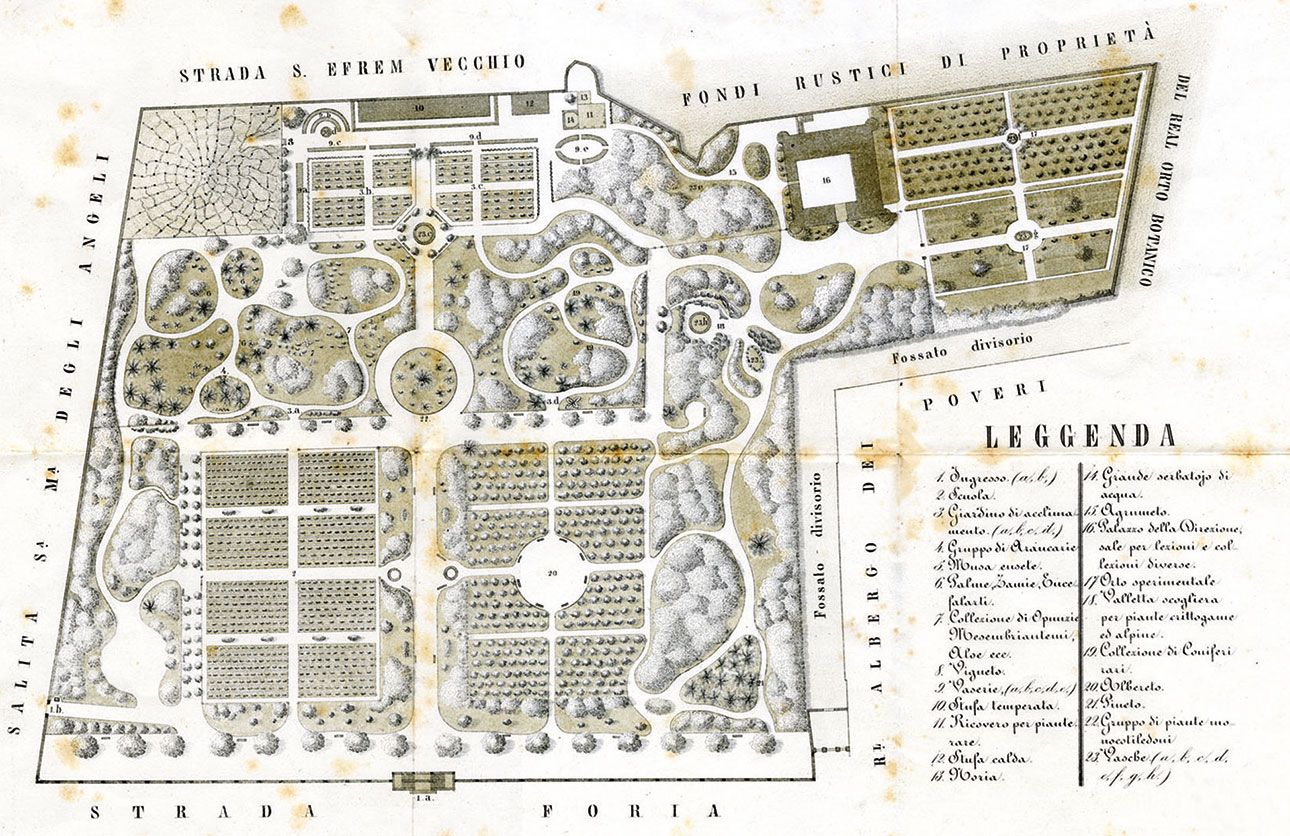 Ancient map of the Botanical Garden of Naples.
Ancient map of the Botanical Garden of Naples.
In the same article, the purposes underlying the creation of the new structure were identified; the Garden was conceived for the "instruction of the public" and the multiplication of "spices useful for health, agriculture, and industry". From this, it is possible to understand the elements of modernity underlying the foundation of the Neapolitan Botanical Garden, which would distinguish itself since its origins for the multiple functions performed and for its diversified plant heritage.
Michele Tenore
With a royal decree dated March 25th, 1810, the illustrious botanist Michele Tenore (1780-1861) was appointed director of the Botanical Garden. He had studied medicine under Vincenzo Petagna, inheriting from his master a passion for Botany, which he considered not a branch of medicine, but an autonomous science. It was precisely this conception of Botany that led Tenore to organize the Garden scientifically in a way that was completely new compared to the previous herb gardens born in Naples.
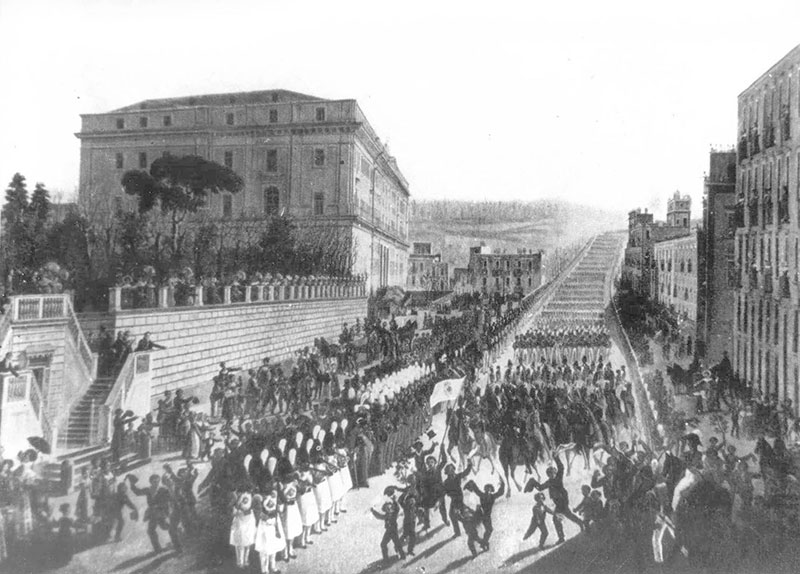 Return of King Ferdinand I of the Two Sicilies to Naples (1815), by Salvatore Fergola.
Return of King Ferdinand I of the Two Sicilies to Naples (1815), by Salvatore Fergola.
Tenore remained director until 1860, and during his 50 years of leadership, he enriched the collections of the Garden, bringing the number of cultivated plant species to about 9,000. Among the most important projects carried out by Tenore was the study of the flora of the Kingdom of Naples. He also took care in establishing relationships with the main European botanical institutions, thus making the structure he directed known and appreciated in other countries. Among the numerous activities carried out in the Garden during his tenure, we recall scientific research, the cultivation of species of medicinal interest, teaching, planning of the Bourbon Royal Sites, and the collection, multiplication, and dissemination of exotic plants. The latter were usually acclimatized in the Temperate House and in the Hot House which has been flanking the formersince 1818.
A thorough analysis of this scientist and of his work was published by Giacomini in a 1962 article in the journal of the Institute and Botanical Garden of Naples on the occasion of the centenary of his death.
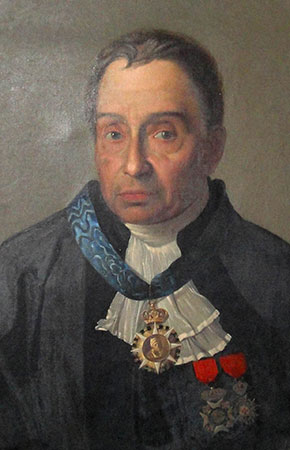 Portrait of Michele Tenore preserved in the Historical Library of the Botanical Garden of Naples.
Portrait of Michele Tenore preserved in the Historical Library of the Botanical Garden of Naples.
Guglielmo Gasparrini
Guglielmo Gasparrini (1803-1866) succeeded Michele Tenore as director of the Botanical Garden of Naples. During his tenure from 1861 to 1866, he reorganized some areas of the Garden, such as the arboretum, the citrus grove, and the fruit garden, which had fallen into a state of neglect during the last years of Tenore's direction. Additionally, a hollow for the cultivation of alpine plants was created, and a new heated greenhouse was built to replace the old one. Among other activities, Gasparrini was also involved in the arrangement of the botanical museum and the organization of the herbarium, which was enriched by Tenore's collections.
Vincenzo Cesati
After Gasparrini's death, Giuseppe Antonio Pasquale (1820-1893) was appointed interim director, and in 1868, the direction was entrusted to Vincenzo Cesati (1806-1883), who led the Garden until the year of his death. During his direction, a new heated greenhouse was built, and the opening of the Botanical Garden to the public on weekdays was formalized. He fought for a long time to make the Garden's borders safe, as at the time three sides were not provided with border walls. He was not successful, but he paved the way for the subsequent construction of the present-day walls.
Giuseppe Antonio Pasquale
The direction subsequently returned to Giuseppe Antonio Pasquale, who held it until 1893, albeit in such poor health conditions that he had to be assisted by collaborators and by his son starting in 1886. During his direction, Pasquale managed to prevent a project that planned to build new premises for university institutes in the area where the Botanical Garden was located.
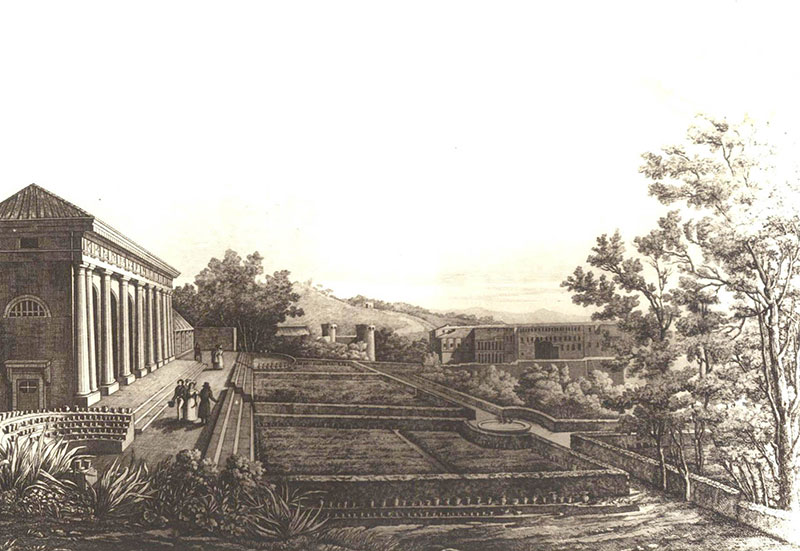 View of the Monumental greenhouse, today Serra Merola. Copper engraving attributed to Giacinto Gigante.
View of the Monumental greenhouse, today Serra Merola. Copper engraving attributed to Giacinto Gigante.
Federico Delpino
Federico Delpino (1833 - 1905) succeeded Pasquale as director of the Botanical Garden of Naples and remained in office until 1905. A distinguished scholar of plant evolution and pollination, he arrived in Naples from the University of Bologna only in the final parte of his brilliant career. The biggest problem he faced was the very low sensitivity of the university authorities towards the Garden, which led to various financial and management issues and initiated a slow decline of the structure. Under his direction, the official journal of the Garden, the “Bullettino dell’Orto Botanico della Real Università di Napoli” (Bulletin of the Botanical Garden of the Royal University of Naples) was founded.
Fridiano Cavara
Numerous changes occurred during the period in which Fridiano Cavara (1906 -1929) was director. He enriched the collections and created an area for xerophytes and succulents, a pond, and two tanks for the cultivation of aquatic plants. He also restored the temperate greenhouse and oversaw the construction of a new building for the Institute of Botany for over a decade. His greatest merit was undoubtedly the establishment, in 1928, of the “Stazione sperimentale per le piante officinali” (Experimental Station for Medicinal Plants), intended for the cultivation and experimentation of medicinal plants and linked to the Italian colonial experience of those years. This structure, endowed with its own funds, functioned under the direct control of the Garden's direction, although it was not part of such a structure from an institutional point of view.
Biagio Longo
In 1930, the directorship passed to Biagio Longo (1872 - 1950), who continued the work begun by his predecessor. Between 1936 and 1938, the Institute was transferred to the new headquarters, whose construction, lasting 18 years, finally ended. Previously, in 1933, an office and laboratory building was built for the Experimental Station for Medicinal Plants. The climax of the Garden's activities during this period was reached in 1940, with an extraordinary meeting of the Italian Botanical Society, held on the occasion of the inauguration of the “Mostra d’Oltremare” (Overseas Exhibition). In the following years, the War severely affected the Garden: all the iron structures were torn down for military use; large-scale cultivation of legumes, potatoes, and wheat was introduced; the population entered the Garden several times to seek shelter and water. The bombings greatly damaged the Garden, like the city, but the real devastation was wrought during the occupation of the Allied troops. The new Institute, as well as part of the old one, was used as barracks; the lawns were covered with concrete or sterilized and used as parking lots for military vehicles; part of the Garden was transformed into a soccer field (the Naples soccer team played there in the spring of 1945!). In 1947, shortly after the end of his directorship, Longo published a report that testified to the total ruin of the structure.
To see some historical images, click here.
Giuseppe Catalano
This situation was inherited by Giuseppe Catalano (1888 - 1981), who served as director from 1948 to 1959. During this period, the old Institute was partially renovated, and the new one was completely rebuilt, partly through the work of the Civil Engineering Corps and partly thanks to the extraordinary funds made available to the management of the Botanical Garden. The iron gates were restored, and the greenhouses were refurbished. In particular, an advanced body with a large tank was added to the heated greenhouse. The lawns were freed from concrete pavements and enriched with tree species. The hollow where alpine plants were kept was transformed into a fern garden.
Valerio Giacomini
Valerio Giacomini (1914 - 1981), a most illustrious scholar in geobotany and plant ecology, substantially maintained the situation inherited from Catalano at the Botanical Garden. However, during his brief tenure (1959-1963), he acquired an important book collection for the Garden's library and initiated a significant restructuring project, of both the buildings and of the administration of the Botany Institute, also creating a new location for the Herbarium.
Aldo Merola
In 1963, Aldo Merola (1924 - 1980) became the director. Thanks to the tireless work of this scholar,a rebirth and a renewal of the Botanical Garden of Naples took place. The premise for this rebirth was the achievement of administrative and financial autonomy for the structure in 1967, which, among other things, allowed for extraordinary funding, such as that from the Italian Research Council (“Consiglio Nazionale delle Ricerche”, C.N.R.), by which, at the end of the 1960s, a complex of greenhouses covering 5000 square meters was built. In addition, a heating system was installed in the temperate greenhouse, and some small transplant greenhouses were built. With the creation of a water distribution network, a major problem was addressed: in fact, water up to that time had been drawn from a well and conveyed to collection tanks from which it was manually drawn. Merola was also interested in botanical gardens at the legislative level, attempting, as far as possible, to sensitize political power to the problems of these structures. The greater fund availability also allowed for the purchase of some agricultural machinery with great benefit to the work in the Garden. The only three usable rooms of the Castle were employed as the offices of the Botanical Garden, while the new building became the seat of the Institute of Botany, now a separate institution. In the early 1970s, the Experimental Station for Medicinal Plants was abolished, so the cultivation area, personnel, and structures became an integral part of the Garden. The collections, which were extremely impoverished, were greatly increased through the purchase of plants from different parts of the world and, mainly, thanks to the collection of plant specimens in nature during botanical expeditions in which young Italian botanists and a distinguished amateur botanist, Professor Luigi Califano (1901 - 1976), Professor of General Pathology at the University of Naples and member of Accedemia dei Lincei, also participated. In particular, the collections of cycads, tillandsias, succulents, and ferns were greatly enriched. Merola re-established contacts with other European botanical gardens, promoting the exchange of plant material and scientific experiences and thus inserting the structure he directed into a scientific reality on a broader scale. Merola was also very attentive to strengthening the educational role of the Garden, providing all plants with labels showing taxonomy and distribution data for each species, creating new exhibition areas, and reorganizing some pre-existing sectors. In the creation of new areas, a systematic criterion was followed in some cases, while an ecological criterion was followed in others.
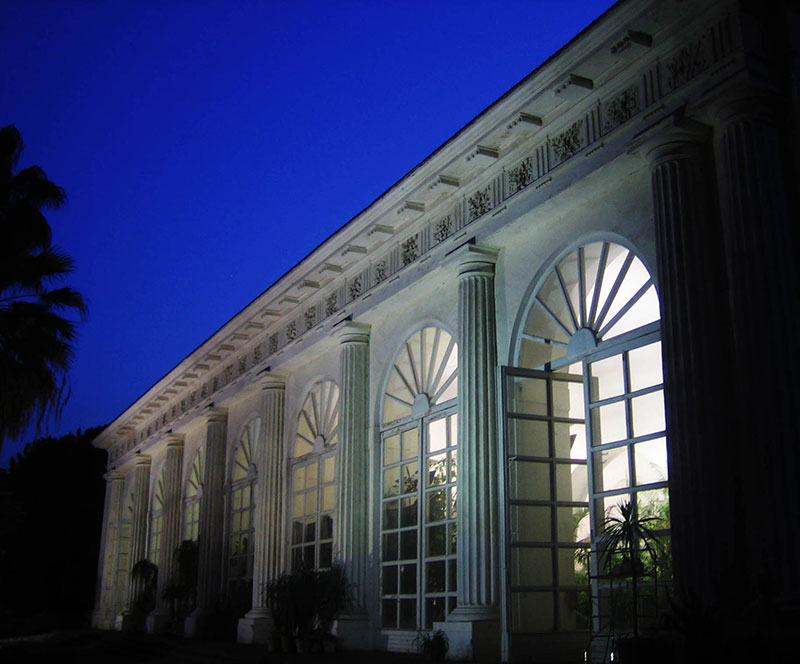 Night view of Merola greenhouse.
Night view of Merola greenhouse.
Giuseppe Caputo
After the sudden death of Merola in November 1980, the direction was taken by Giuseppe Caputo (1926 - 2013). During this period, the city was hit by a disastrous earthquake that caused considerable damage to the Castle, as well as to the Garden, which was invaded for several days by the population seeking shelter and even by armored vehicles that entered the Garden to secure the adjacent Albergo dei Poveri, partly damaged in the aftermath of the earthquake. Freed with the help of the police, the Garden was equipped with an armed surveillance service, also to curb the continuous thefts perpetrated against the structure.
Paolo De Luca
At the end of 1981, Giuseppe Caputo became director of the Botanical Institute, and Paolo De Luca (1944 - 2021) was appointed director of the Garden. The repair of the earthquake damage was partly carried out with funds allocated by the government for the reconstruction of areas affected by the earthquake. The Castle, partially destroyed by the earthquake, was completely restored. Thanks to the funds granted by the Superintendent of Monuments, even the facade, over 200 meters long, and the monumental greenhouse, currently dedicated to Aldo Merola, were restored. The complex of new greenhouses, already dedicated during Merola's management to Luigi Califano, was equipped with heating and humidification systems, while the small transplant greenhouses were renovated. The gardeners' changing rooms, in a dilapidated condition, were completely rebuilt and equipped with heating. Thanks to the completion of the water network, today the water from an artesian well reaches every area of the Garden. The collections were further enriched by purchased specimens and plants collected in nature. Some areas, not yet restored by Merola, were cleared of brambles and rearranged; moreover, the completely abandoned area that previously hosted the Experimental Station, now called the "Experimental Section of Medicinal Plants," was recovered. The citrus grove, reduced to a few specimens of the old collection planted around the mid-19th century, was enriched with numerous new species of genus Citrus and related genera. To the exhibition areas created by Merola, the "Mediterranean scrubland" was added, a collection of the most representative plants of this environment. Other new areas created under De Luca's direction are the area for the visually impaired, the area of biblical plants, the chromo-sensory garden, the area dedicated to the ancestors of edible fruits, and the area dedicated to the plants of the Hamadryads. In addition, Paolo De Luca built a new tropical greenhouse, in the style of the ancient heated greenhouse that fell into disuse, in which the environment of the Mexican Atlantic coasts is recreated.
Paolo Caputo
Paolo Caputo has been serving as director of the Botanical Garden since November 2014.
Timeline of Directors
(in italics, interim or substitute directions)
1810-1860: Michele Tenore
1860: Vincenzo Tenore
1861-1866: Guglielmo Gasparrini
1866-1868: Giuseppe Antonio Pasquale
1868-1882: Vincenzo Cesati
1883: Gaetano Licopoli
1883-1893: Giuseppe Antonio Pasquale
1886-1890: Fortunato Pasquale
1890-1893: Francesco Balsamo
1893-1905: Federico Delpino
1905-1906: Arnaldo Piutti
1906-1929: Fridiano Cavara
1930-1947: Biagio Longo
1947-1959: Giuseppe Catalano
1959-1963: Valerio Giacomini
1963-1980: Aldo Merola
1980-1981: Giuseppe Caputo
1981-2014: Paolo De Luca
2014-oggi: Paolo Caputo
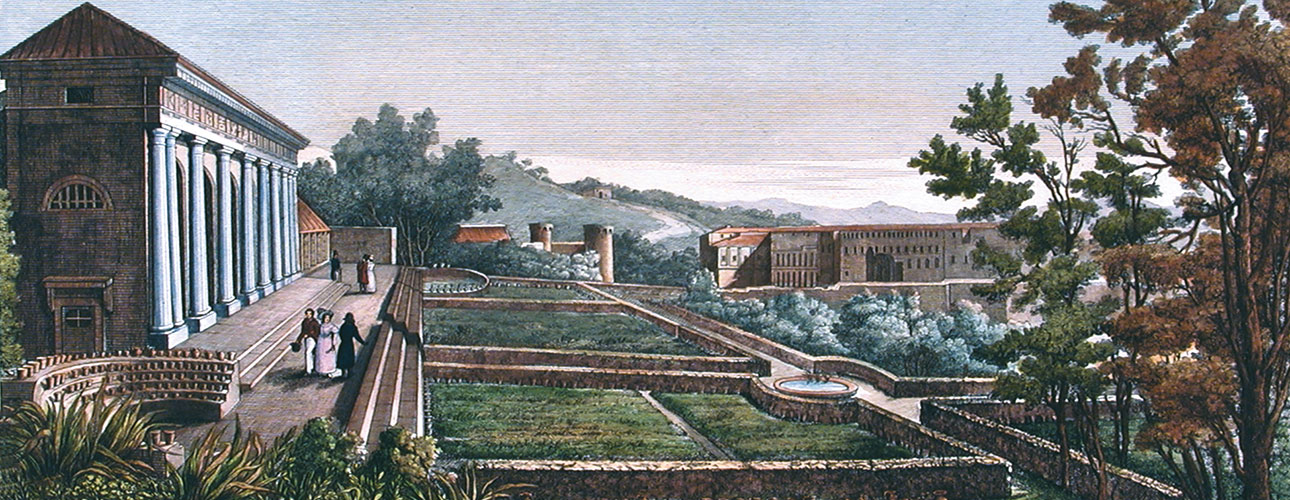

 Sistema Museale di Ateneo
Sistema Museale di Ateneo